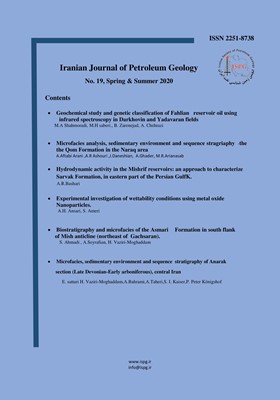مقایسه کارکرد شبکه های عصبی مرسوم برای برآورد تخلخل در یکی از میدانهای نفتی جنوب خاوری ایران
الموضوعات : Geoscience Fields in relation with Petroleum Geologyفرشاد توفیقی 1 , پرویز آرمانی 2 , علی چهرازی 3 , اندیشه علیمرادی 4
1 - دانشجو دانشگاه بین اللملی قزوین
2 - دانشگاه بین المللی امام خمینی(ه)
3 - کارشناس ارشد
4 - استاد یار دانشگاه بین المللی امام خمینی، قزوین
الکلمات المفتاحية: برآورد تخلخل, بازگردانی,
ملخص المقالة :
در صنعت نفت از هوش مصنوعی برای شناسایی روابط، بهینه سازی، برآورد و رده بندی تخلخل بهره گیری میشود. یكی از مهمترین مراحل ارزیابی پارامترهای پتروفیزیكی مخزن، شناسایی ویژگیهای تخلخل است. هدف اصلی این پژوهش مقایسه درستی و تعمیم پذیری سه شبكه عصبی چند لایه پیشخور ) MLFN (، شبكه تابع شعاع مبنا ) RBFN ) و شبكه عصبی احتمالی ) PNN ) برای برآورد تخلخل با بهره گیری از ویژگیهای لرزهای است. در این راستا، دادههای زمینشناسی 7 حلقه چاه یک میدان نفتی فراساحلی هندیجان در شمال باختری حوضه خلیج فارس مورد ارزیابی قرارگرفت. امپدانس آکوستیک با بهرهگیری از روش وارونگی مبتنی بر مدل برآورد شد و سپس شبكههای عصبی یاد شده با بهرهگیری از ویژگیهای لرزهای بهینه طراحی شده و با روش رگرسیون گام به گام مورد ارزیابی قرار گرفتند. سرانجام مشخص شد که مدل MLFN برای برآورد تخلخل خوب عمل نمیکند. PNN از بهترین دقت کارکرد در درون یابی تخلخل برخوردار است، اما تعمیم پذیری RBFN بهتر است.
[1] AMINI, A., MOVAHED, B., BEHZAD, ASIRI, H., and MARZAYI, TABESH, F., 2014, Design of Artificial Neural Network for Prediction of Porosity of Asmari Reservoir in Rag-Sefied Field Using Logarithmic and Porous Porosity Data: 3rd National Oil, Gas and Petrochemical Conference, Gachsaran, Iran.4-5.
[2] ANEES, M., 2013, Seismic attribute analysis for reservoir characterization: 10th Biennial International Conference and Exposition on the theme “Changing Landscapes in Geophysical Innovations”, India, 119-122.
[3] ASOODEH, M., and BAGHERIPOUR, P., 2013, Core porosity estimation through different training approaches for neural network: back-propagation learning vs. genetic algorithm: International Journal of Computer Applications, 63, 5:11–15.
[4] BEDI, J., and TOSHNIWAL, D., 2019, PP-NFR: an improved hybrid learning approach for porosity prediction from seismic attributes using non-linear feature reduction: Journal of Applied Geophysics, 166, 22-32.
[5] CAO, J., YANG, J., WANG, Y., WANG, D., and SHI, Y., 2015, Extreme Learning Machine for Reservoir Parameter Estimation in Heterogeneous Sandstone Reservoir: Mathematical Problems in Engineering, 287816, 1-10.
[6] CHOPRA, S., and MARFURT, K.J., 2007, Seismic Attributes for Prospect Identification and Reservoir Characterization: (chapter 1) 1st ed. Society of Exploration Geophysicists. 1-24
[7] ELKATANY, S., TARIQ, Z., MAHMOUD, M., and ABDULRAHEEM, A., 2018, New insights into porosity determination using artificial intelligence techniques for carbonate reservoirs: Petroleum Journal, 4, 4:1-11.
[8] EZEKWE, J.N., 2003, Applied Reservoir Management Principles with Case Histories: SPE Annual Technical Conference and Exhibition. Colorado. 5-8.
[9] FAUSETT, L.V., 1994, Fundamentals of Neural Networks Architectures: Algorithms and Applications (chapter 1) 1st ed. Pearson. 3-4
[10] GHARECHELOU, S., AMINI, A., KADKHODAIE-ILKHCHI, A., and MORADI, B., 2015, An integrated approach for determination of pore-type distribution in carbonate-siliciclastic Asmari Reservoir, CHESHMEH-KHOSH Oilfield, SW Iran: Journal of Geophysics and Engineering, 12, 793-809.
[11] GHAZBAN, F., 2007, Petroleum Geology of the Persian Gulf (chapter 9) 1st ed. Tehran, Tehran University and National Iranian Oil Company publication, 586-587.
[12] GHOLAMI, A., and ANSARI, H.R., 2017, Estimation of porosity from seismic attributes using a committee model with bat-inspired optimization algorithm: Journal of Petroleum Science and Engineering, 152, 238-249. [13]
HOSSEINI, A., ZIAII, M., KAMKAR ROUHANI, A., ROSHANDEL, A., GHOLAMI, R., and HANACHI, J., 2011, Artificial Intelligence for prediction of porosity from Seismic Attributes: Case study in the Persian Gulf: Iranian Journal of Earth Sciences, 3. 2:168-174. [14]
HUUSE, M., and FEARY, D.A., 2005, Seismic inversion for acoustic impedance and porosity of Cenozoic cool-water carbonates on the upper continental slope of the Great Australian Bight: Marine Geology, 215, 3-4:123-134. [15]
ITURRARÁN-VIVEROS, U., and PARRA, J.O., 2014, Artificial Neural Networks applied to estimate permeability, porosity and intrinsic attenuation using seismic attributes and well-log data: Journal of Applied Geophysics, 107, 45-54. [16]
MCCULLOCH, W.S., and PITTS, W., 1943, A logical calculus of the ideas immanent in nervous activity: Bulletin of Mathematical Biophysics, 5, 115–[17] MCPHEE, C., REED, J., and ZUBIZARRETA, I., 2015, Core Analysis: A Best Practice Guide, (chapter 8) 1st ed. Edinburgh, Elsevier Publication, 347-[18]
MOJEDDIFAR, S., KAMALI, G., RANJBAR, H., and SALEHIPOUR BAVARSAD, B., 2014, A comparative study between a pseudo-forward equation [pfe] and intelligence methods for the characterization of the North Sea reservoir: International Journal of Mining and Geo-Engineering, 48. 2:173–[19] ORR, M.J., 1996, Introduction to Radial basis function neural networks: Research Report for the Institute of Adaptive and Neural Computation, University of Edinburgh. 9-11.
[20] POWELL, M.J.D., 1987, Radial basis functions for multivariable interpolation: a review, Algorithms for Approximation: Clarendon. 143– 167.
POWELL, M.J.D., 1987, Radial basis functions for multivariable interpolation: a review, Algorithms for Approximation: Clarendon. 143– 167. [21] RONEN, S., SCHULTZ, P.S., HATTORI, M., and CORBETT, C., 1994, Seismic guided estimation of log properties, Part 1, 2 and 3: The Leading Edge, 13: 305-10, 674-678, 770-776. [22]
RUSSELL, B.H., 1988, Introduction to seismic inversion methods (Chapter 8) 1th ed. Calgary, Society of exploration Geophysicist, 1-14. [23]
RUSSELL, B.H., 2004, The application of multivariate statistics and neural networks to the prediction of reservoir parameters using seismic attributes: Ph.D. thesis, Faculty of Graduate Studies, Dissertation University of Calgary. 17-18. [24]
SOLEIMANI, B., BAHADORI, A., and MENG, F., 2013, Microbiostratigraphy, microfacies and sequence stratigraphy of upper cretaceous and Paleogene sediments, Hendijan oil field, Northwest of Persian Gulf, Iran: Natural Science, 5. 11:1165-1182. [25]
SPECHT, D.F., 1990, Probabilistic neural networks: Neural Networks, 3, 1:109–118. [26]
TARANTOLA, A., 2005, Using the Solution of the Inverse Problem, 1st ed. Paris, Society for Industrial and Applied Mathematics, 37-38. [27] YAZDANIAN, J., and NOORI, B., 2007, Geological Final Report-Well HD_7, Iranian Offshore Oil Company


